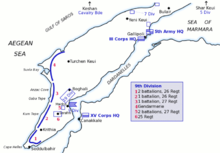1st Royal Naval Brigade
To meet this shortfall, troops were withdrawn from overseas postings and the Dominions as reinforcements for the expeditionary force sent to France.
These forces were organised along the same lines as their counterparts in the army, except for small details such as the rank of the commanding officer, and lack of bands, etc.
The new brigade was initially organised with four battalions from local naval stations and ships, and named after according to where the majority of its personnel came from.
[3] On 4 October 1914, the two newly formed naval brigades received orders to embark at the Port of Dover for a move to France.
This position however, was seen as untenable and during the night of 6–7 October, the (now organised) Royal Naval Division withdrew and occupied the 2nd line of trenches.
However, around 1,500 men (almost all from the 1st Naval Brigade, including its commander), failed to break through and had to cross the Dutch frontier where, on the 9th, they were interned in accordance with that country's neutrality laws.
[4][5] After a large amount of the 1st Naval Brigade had been captured trying to escape from Belgium, the division was embarked on ships in Ostend and reached Dover on 11 October.
For a short time, the division was scattered around Kent and Sussex, finding accommodations wherever available, the Royal Marine battalions however returned to their various barracks.
[7] Casualties before the campaign began included Rupert Brooke, who died at sea from an infected mosquito bite on 23 April 1915.
Eleven troopships and Canopus, Dartmouth and Doris, two destroyers and trawlers rendezvoused off Bulair before dawn and the warships began a day-long bombardment, just after daybreak.
In the late afternoon men began to embark on the boats, which headed for the shore just before dark and returned after night fell.
During the night Lieutenant-Commander Bernard Freyberg swam ashore and lit flares along the beach, crept inland and observed the Ottoman defences.
Just after dawn, the decoy force sailed south to join the main landings, coming ashore on 30 April.
[2][3] Captain Henderson had previously been Royal Naval Attaché to the German Empire prior to the outbreak of the war.
[10][11] At some point just before the end of the Siege of Antwerp, Colonel David Mercer CB RM took command of the brigade.
[13][14][15][16][17] Although supporting troops of the Royal Naval Division wore the anchor divisional sign, in a variety of combinations of colours, it was not worn by the infantry.



